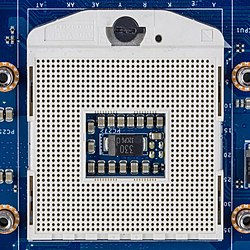 | |
| Type | rPGA |
|---|---|
| Chip form factors | Flip-chip pin grid array |
| Contacts | 988 |
| FSB protocol | DMI |
| FSB frequency | 2.5GT/s [1] : 14 |
| Voltage range | Max. 1.4 V (core) Max. 1.55 V (graphics) [1] : 92 |
| Processor dimensions | 37.5 × 37.5 mm |
| Processors | Clarksfield Arrandale |
| Predecessor | Socket P |
| Successor | Socket G2 |
| Memory support | DDR3 |
This article is part of the CPU socket series | |
Socket G1, also known as rPGA 988A, is a CPU socket introduced by Intel in 2009 for the mobile variants of the first-generation Intel Core processors. [1] It is the successor to Socket P, and the mobile counterpart to LGA 1156 and LGA 1366.